Command Palette
Search for a command to run...
Former OpenAI Vice President and DeepMind Scientists Launch Startup: Over 20 Elite Scientists and $300 Million Bet on "AI for Science".

In the spring of 2025, a shocking resignation announcement was released:Liam Fedus, who previously served as VP of Research at OpenAI and was in charge of post-training, has decided to leave.In a tweet, he wrote that he has "the most strategic interest" in "the application of AI in science"—that is the direction in which he will explore new horizons.

at the same time,Another heavyweight figure: Ekin Dogus Cubuk—He once led the chemistry and materials science team at DeepMind and participated in more than two million crystal structure generation projects, but he resolutely chose to leave DeepMind and turn to entrepreneurship.
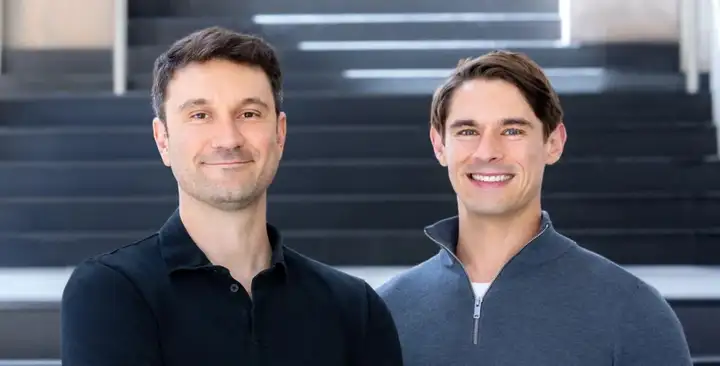
"The valuable data from the 10 trillion tokens on the internet is nearly exhausted; expanding parameters won't bring about a qualitative leap," Fedus stated bluntly in his presentation. Cubuk's addition was even more insightful: "Relying solely on LLM deductions in the literature will never lead to groundbreaking discoveries like room-temperature superconductors."
then,The two hit it off at the beginning of this year.Instead of getting bogged down in the "involution" of existing data pools, let AI enter the laboratory and create data from scratch.
Initial motivation: A collision of inspiration between AI and physics
Periodic Labs was founded on a brainstorming session. Seven months earlier, Fedus and Cubuk were in San Francisco discussing how generative artificial intelligence could reshape the process of scientific discovery. Both had witnessed the power of AI in their respective labs, but also felt its limitations.
"We realize that generative AI can already write papers, program, and even draw, but it hasn't truly helped humans discover new knowledge yet."Fedus recalled, "The scientific community is too slow in experimenting, and AI is ready to change all that."
Cubuk, however, approaches the issue from a physics perspective, observing that the technological curves of robotic automation, materials simulation, and AI inference converge at the same point in time. "This is an unprecedented opportunity," he explains."Robot automation, simulation accuracy, and the reasoning capabilities of large language models can finally be integrated into a single system."
That conversation became the starting point for Periodic Labs. A few weeks later, the two officially left their respective companies, gathered a group of like-minded scientists, and founded a research company that drives experimental science with AI.
Disrupting Traditional Concepts: Building an AI-Driven Scientific Platform
Periodic Labs claims to be building an "AI-driven science platform."Its vision is to enable artificial intelligence not only to analyze data, but also to design experiments, drive physical instruments, and discover new materials.
In other words, it attempts to integrate "intelligence" and "experimental operation" into a closed-loop system—from algorithms to reagent bottles, from large models to robotic arms.
This is not a new topic. Over the past decade, AI has made breakthroughs in areas such as drug design, protein folding, and materials simulation—DeepMind's AlphaFold, Microsoft and Meta's molecular generation models, and Chemify's automated chemistry system all demonstrate that AI can participate in scientific discovery.
But Periodic Labs' goals are bigger than that. Fedus and Cubuk want to create a "universal experimental platform"—one that allows AI not only to understand science but also to conduct experiments in real labs.
In Periodic Labs' philosophy,There is a very disruptive idea: data from failures is just as valuable.
Traditional scientific research tends to prioritize the publication of "successful experiments," neglecting the thousands of "negative results." Fedus and Cubuk believe these "failures" are precisely the key fuel for training AI scientists. "Every deviation in an experiment, every error feedback, is an opportunity for the model to understand the physical world," Cubuk says. "AI isn't afraid of failure; it's only afraid of the lack of data."
Therefore, Periodic Labs is not in a hurry to publish its results, but focuses more on accumulating experimental data to build an unprecedented "scientific experience database" to lay the foundation for the next generation of scientific AI.
Technology Stack: Synchronizing AI, Simulation, and Robotics
In Periodic Labs' laboratory, robotic arms are precisely mixing metal powders, high-temperature furnaces are heating up according to a preset program, and spectrometers are capturing material property data in real time—this isn't a scene from a science fiction movie, but rather the daily operation of its "autonomous laboratory" in the future. This system was inspired by Cubuk's groundbreaking research published in Nature in 2023.Back then, the A-Lab platform he led synthesized 41 new compounds in 17 days.This demonstrates the feasibility of AI-driven experiments.
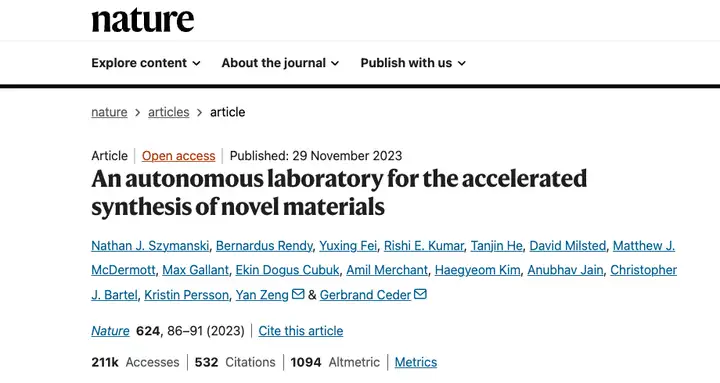
Paper link:
https://www.nature.com/articles/s41586-023-06734-w
Today, Periodic Labs takes this logic to its extreme. Its core innovation lies in its "trinity" science stack:
* Autonomous Robotic Lab:It can perform powder synthesis, substance mixing and material preparation in a fully automated environment, accurately execute experimental instructions, and greatly improve the speed and repeatability of scientific research.
* High-Fidelity Simulation:AI-driven simulation technology enables rapid evaluation of physical and chemical reactions in a virtual environment, providing a high-precision hypothesis verification platform for experimental screening.
* Large Language Model Research Assistant (LLM Research Assistant):Language models are no longer just about generating text; they can analyze experimental data, offer suggestions for improvement, and design the next round of experiments, truly becoming the "cognitive center" of the research process.
The three elements form a closed-loop system. First, an AI system integrating LLM and physical simulation analyzes literature and generates experimental hypotheses. Then, automated equipment performs synthesis and characterization, generating several gigabytes of high-dimensional physical data in each round of experiments. Finally, the AI analyzes the results (regardless of success or failure) and optimizes the next round of solutions. This cycle of "virtual simulation – physical verification – data feedback" completely overturns the traditional scientific research model, exponentially increasing the speed of scientific discovery.
"Our real innovation lies in the way data is produced," Cubuk emphasized. Unlike traditional AI that relies on internet text,The unique data generated daily by their laboratory contains a large number of "negative results" that are ignored in traditional scientific research.In the field of materials science, failed experiments account for over 90% of all experiments (TP3T), and this valuable information, not documented in the literature, becomes the unique nourishment for Periodic Labs' AI models. As the company's website states: "Here, nature itself becomes the reinforcement learning environment."
Behind the technological feasibility lies the simultaneous maturity of three major fields: the precision of industrial-grade robotic arms has reached the 0.1 mm level, sufficient to handle complex synthesis operations; AI-driven physics simulators can control the error in predicting material properties within 5%; and the reasoning capabilities of models such as o1 are already capable of handling complex interdisciplinary tasks such as "designing superconducting crystal structures." The combination of these three technologies makes Fedus's vision of "AI doing science" a reality.
Capital Frenzy: The Silicon Valley Consensus Behind $300 Million
In September 2025, Periodic Labs shocked the industry by announcing the completion of a $300 million seed funding round. This figure not only set a record for seed rounds for AI startups but also revolutionized the venture capital industry. In addition to Andreessen Horowitz leading the investment, top institutions such as a16z, DST, and NVIDIA Ventures all participated in the investment.The list of angel investors is even more star-studded: Amazon founder Jeff Bezos, former Google CEO Eric Schmidt, and DeepMind's key figure Jeffrey Adgate are all included.
The prelude to this capital feast was dramatic. When Fedus announced its departure from OpenAI in early 2025, the Silicon Valley VC circle went into a frenzy: some investors submitted dozens of pages of PPTs to promote themselves, some wrote "love letter-style" letters of intent to invest, and some institutions promised to provide comprehensive support from computing power to supply chain.But the very first phone call they actually received came from Peter Deng.He was Fedus's colleague at OpenAI and later became an investor in Felicis, a top seed company. After hearing Fedus's vision, Deng even forgot that he had to write a check before the company was even registered.
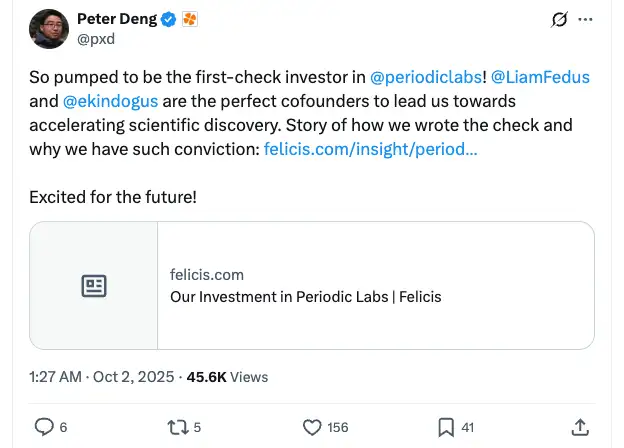
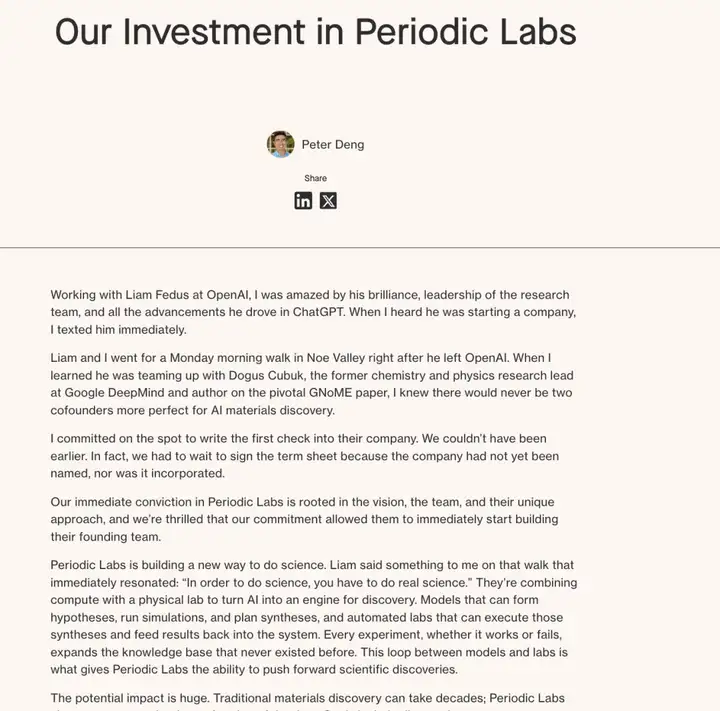
Investors' enthusiasm is not blind. a16z stated explicitly in its investment announcement: "This is an opportunity to compress decades of research progress." In multi-billion dollar sectors such as semiconductor heat dissipation and new energy materials, traditional R&D cycles often exceed 10 years.Periodic Labs' technology roadmap promises to shorten this to a few years.

The absence of his former employer, OpenAI, is intriguing. Although Fedus received well wishes from management upon his departure and even hinted at potential support,Even Sam Altman sent his blessings when the company was founded.However, it ultimately did not appear on the list of investors. Some industry analysts speculate that this may stem from a fundamental difference in technological approaches: OpenAI focuses on general artificial intelligence, while Periodic Labs' "AI for Science" vertical approach is closer to the strategic direction of Google DeepMind.
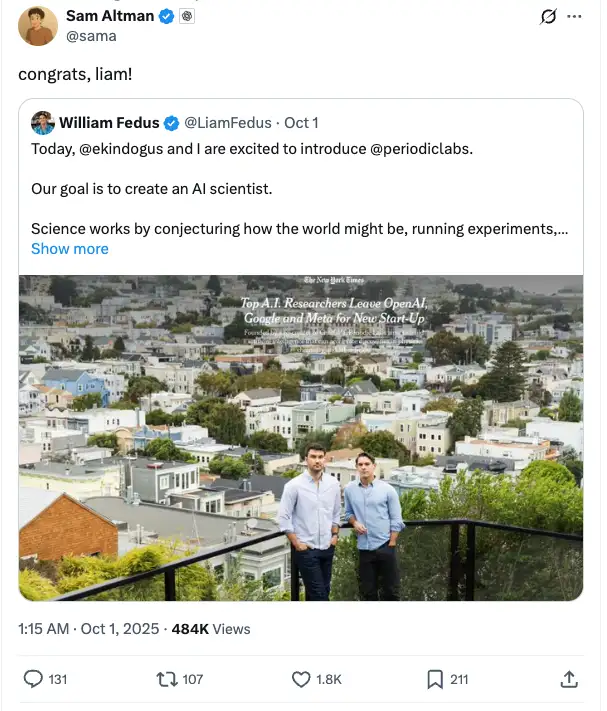
Dream Team: A Mass Migration of Half of Silicon Valley's Elite
Following the receipt of $300 million in funding, Periodic Labs launched one of the most astonishing talent recruitment drives in Silicon Valley history. Within just a few weeks...More than 20 top researchers from Meta, OpenAI, and DeepMind have joined the team.This includes luminaries such as the inventor of the Transformer attention mechanism, the developer of the OpenAI Operator intelligent agent, and the creator of Microsoft's MatterGen large model. Many have given up millions of dollars in stock incentives to dedicate themselves to this "scientific research revolution."
The team's cross-disciplinary nature is truly rare:Half of the members come from the field of AI, while the other half are experts in physics, chemistry, and materials science.
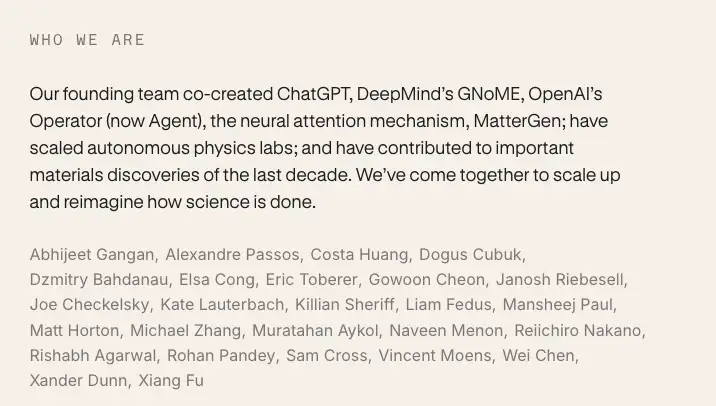
The prestigious advisory board further enhances this cross-disciplinary advantage. The academic committee, led by Nobel laureate Carolyn Bertozzi, includes leading figures in superconductivity physics from Stanford University and materials science giants from MIT, providing AI experts with entirely new search algorithm ideas.
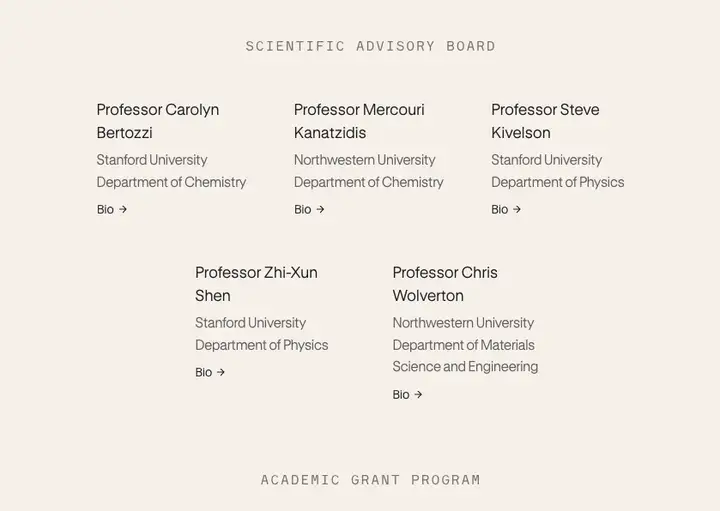
Based on this strong talent poolThe company initially focused on discovering new high-temperature superconducting materials.Since all known superconductors require extremely low temperatures or high pressures to operate, the potential for developing superconductors that operate near room temperature is enormous. Periodic Labs is betting that AI can accelerate the birth of this miracle.
Beyond superconductors, they are also focusing on real-world challenges in fields such as semiconductors. The team is currently collaborating with a chip manufacturer, using specially trained AI agents to optimize heat dissipation materials, helping engineers iterate and solve chip heat dissipation bottlenecks more quickly.
Final Thoughts
From resolutely choosing to leave their jobs to the sensational $300 million funding round, from the clash of ideas between two scientists to the formation of a dream team spanning AI and physics, Periodic Labs has accomplished in less than a year what traditional research institutions take years to achieve. Its "AI scientist + automated lab" model not only has the potential to lead to groundbreaking discoveries like room-temperature superconductivity, but is also reshaping the underlying logic of humanity's exploration of nature.
As Sonal Chokshi, a partner at a16z, said, "Bell Labs changed the world with transistors, IBM Research opened up the future with laser technology, and Periodic Labs is reshaping science itself with AI." When a robotic arm repeats the 1,000th experiment in the laboratory, and when an AI model analyzes the 100,000th set of data, a scientific revolution driven by silicon-based intelligence has begun.
Reference articles:
1.https://techcrunch.com/2025/10/20/top-openai-google-brain-researchers-set-off-a-300m-vc-frenzy-for-their-startup-periodic-labs
2.https://periodic.com/
3.https://globalbizoutlook.com/ai-startup-frenzy-how-periodic-labs-raised-300m-to-revolutionize-scientific-discovery/
4.https://www.felicis.com/insight/periodic-labs-investment
5.https://a16z.com/announcement/i